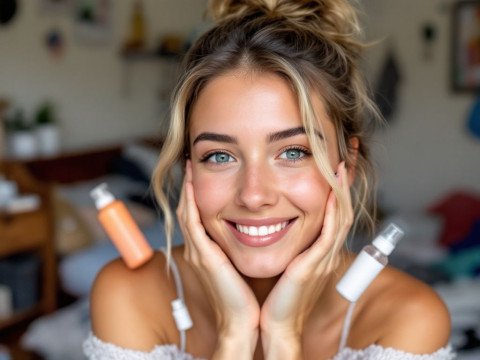Ever noticed those stubborn breakouts popping up more than usual after a long day in the lab? Yep, you’re not alone. Welcome to the world of “work acne,” a term we’ve coined for those pesky blemishes that appear when you’re knee-deep in research and experimentation. Let’s dig into this, uncover some potential causes, and chat about some practical strategies to keep your skin clear even when you’re balancing test tubes and data sheets.
Understanding Work Acne: What’s Up with Your Skin?
First off, let’s get one thing straight: labs are not the most forgiving environments for your skin. We’ve got chemicals, fluctuating temperatures, humidity levels flying all over the place, and long hours under artificial lights. All these factors can gang up on your skin, creating the ideal conditions for work acne.
Why does this happen? In a nutshell, those intrusive irritants clog your pores and throw your skin’s natural balance out of whack. The stress of deadlines and late-night jingles at the lab microwave doesn’t help, either. When your mind’s overloaded with thoughts about your experiments, it’s easy to ignore a few pimples here and there. But, over time, these small skin issues may snowball into bigger problems. Not fun.
The Culprits: What in the Lab Contributes to Acne?
Let’s break it down simply. A few common factors in lab environments can trigger or worsen work acne:
1. Chemical Exposure
Many substances in a lab setting can be irritating to your skin. From solvents and reagents to powders and metals, these chemicals might irritate or sensitise your skin. Even tiny traces of these on your skin’s surface or residues transferred from surfaces you touch can be enough to spark a reaction. Always think about personal protective gear—gloves and face masks aren’t just for project safety; they’re for your skin, too.
2. Humidity and Temperature Fluctuations
Labs can be weirdly climate-controlled zones. Some are so chilly that it feels like winter, while others may be tropical-humidity central. Such fluctuations confuse your skin, leading to excess oil production or dehydration, both of which contribute to work acne. ‘Lab face’ is real, folks.

3. Stress
Deadlines. Results. Experiments. Repeat. The pressure from ongoing research isn’t just mentally exhausting; it can physically manifest as breakouts. When stress hits, your body pumps out more cortisol, a stress hormone that ups oil production in the skin. More oil = more acne. Simple math, right?
Solutions and Strategies: Finding Your Path to Clearer Skin
Okay, we’ve identified the enemies of your skin. Now, let’s talk shopping lists and action plans, because what’s an understanding without a game plan, right?
Stay Protected with Rigor
- Wear Protective Gear Religiously: This means gloves and masks, even if the particular experiment’s ahead-safe by standard protocols. Visualize a protective bubble between your skin and the potential irritants. Now, make it a reality by consistently gearing up.
- Barrier Creams: These gels, like the word suggests, form an invisible barrier against chemicals and irritants. A small but worthy investment for lab-goers.
Perfect Your Lab Hygiene
- Don’t Touch!: It’s tempting, but those hand rests or cheek-cradles while pondering results? Bad move. Your hands are repositories of untold lab residues.
- Sanitize Implements: Regular cleaning routines for lab tools and your workspace are genuinely important. Surfaces, screens, and items you touch frequently should be sans microbes, sometimes hourly.
- Frequent Hand-Washing: The quintessential hygiene mantra applies here too. But remember to follow it up with moisturizing to prevent dryness, which just adds fuel to the breakout fire.
Tweak Your Skin Care Routine
- Effective Cleansing
Use a gentle yet effective cleanser post-lab sessions. Look for products that promise to wash off pollutants without being too harsh. You don’t want a cleanser that strips your skin dry. That would be another problem altogether.

- Tailored Moisturization
Think “hydration with a purpose.” Choose moisturizers that are non-comedogenic (won’t clog pores) and are maybe even geared towards soothing stressed-out skin.
- Regular Exfoliation
Exfoliate, but not religiously. Choose chemical over physical exfoliants to help remove dead cells with less irritation. Mandelic acid or gentle enzymes could be your new best friend here.
- Weekly-Dose Masks
Give settling clay masks a try once a week. They’re pretty great at controlling oil and reducing inflammation without stripping skin.
Manage the Mess: Handling Active Breakouts
Don’t panic when pimples appear. React gently. Use spot treatments sparingly—ingredients like benzoyl peroxide or salicylic acid can zap a zit if you apply the right dose sensibly.
Overcome The Stress Within
This loops us back to inside-out care. Relieving work stress when possible helps on all fronts:

- Develop a strong research routine to prevent last-minute panic.
- Streamline tasks and delegate portions of team projects when needed.
- Step away and breathe, even during tough lab days. Even little stress relievers can lift a lot of emotional burden.
Sleep, Food, and Habits Alignment
There’s a real benefit to be found in regular training habits like getting enough sleep, eating with no-nonsense nutritional logic, hydrating and staying active with even low-impact exercises. All work wonders for overall skin health.
At-Home Experimentation: Test And Track Your Skin’s Response
Science folks like us can’t resist little experiments. Testing new skincare products, well, needs patience and keen observation. Try to keep a texture journal, jot down what your skin loves or hates. Tweaking routines and noting responses isn’t time-consuming but a task of interest—it’s the scientist’s special introspection. Trust me, chalk up results you learn here against the variables you face daily.
Common Misconceptions About Work Acne
We hear you, concerned peeps: skincare can seem like this convoluted fairy tale where breakout goblins lurk on every avoidance trail. Here’s a list that may free you mentally, to navigate that noise:
- Skincare Doesn’t Have to Break the Bank: Quality isn’t always connected to cost. It’s the ingredients that matter, sharp focus on what’s actually needed by your skin.
- More Products Aren’t the Answer: It’s about a curated process rather than sheer volume of products used.
Circling back, remember—simple definitions, the regularity and persistence habits spell out eventual resolutions.
Self-Compassion: Action Breeds Calmness
One last loop around to soothe your scientist self: accept work acne as a journey, without burdensome judgment. Empathize with your own explorative pathways, as forgiving yourself extends to allowing positive change over dictated perfections.
Navigating skin care in a lab-centric environment can become second nature with some strategic actions and a sprinkle of patience. Give these approaches a try, and you’ll be the lab guru whose skin defies the odds, becoming clearer and more resilient over time. You’re doing science, and now you’re scientifically skilled in framing yourself best—you’ve got this!
Frequently Asked Questions
What causes acne?
Acne is caused when hair follicles become blocked with oils, dead skin cells, and bacteria. The sebaceous glands produce sebum, an oily substance, which can be stimulated by hormones such as androgens (including testosterone). This excess sebum, combined with dead skin cells and bacteria like *Cutibacterium acnes*, clogs the hair follicles and leads to inflammation and acne[1][3].
What are the common symptoms of acne?
The symptoms of acne include inflamed, raised bumps (papules), pustules (pimples filled with pus), whiteheads and blackheads (clogged pores), and painful cysts or nodules. Acne can also lead to dark spots and scarring. These symptoms often appear on the face, neck, shoulders, chest, and upper back[1][5].
What are the risk factors for developing acne?
Risk factors for acne include genetic predisposition, dietary factors such as a high glycemic load diet, endocrine disorders like polycystic ovary syndrome, certain medications like corticosteroids and anabolic steroids, stress, and the use of certain skin care products. Additionally, hormonal changes during puberty, pregnancy, and the menstrual cycle can trigger acne[1][3].
Can acne be influenced by lifestyle or environmental factors?
Yes, acne can be influenced by lifestyle and environmental factors. For example, smoking, high glycemic index diets, and certain cosmetic products can contribute to acne. Additionally, stress and exposure to sunlight or sunbeds, which can increase skin sensitivity and risk of skin cancer, are also factors to consider[1][3].
References










